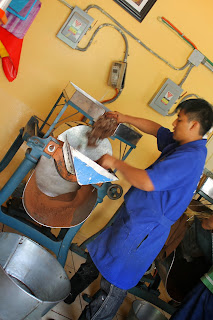WARNING: There are many pictures in this blog entry. The process was so interesting and the colors so amazing!
Here is the wool yard before it has been washed and dyed.
The ladies are preparing the fire for the natural dyes. They used pecan shells for the brown and some kind of plant for a green color.
Washing the wool.
The kids enjoyed watching the ladies dye the wool.
Watching the process with our friends who invited us along on their fieldtrip.
Adding plants to the boiling water to get a new color.
Carding the wool to make it smooth and ready to go on the spinning wheel.
What beautiful colors come from our earth!
The beginnings of a wool rug.
Preparing the wool for the spinning wheel.
Turning the wool into yarn. This lady did it so quickly and perfectly even.
I'm sure she's had years of practice.
Kieran was trying to decide if he wanted to give it a try.
With mom's help, he jumped it. It was much harder than it looked!
These intricate rugs take a lot of concentration and time.
Pure indigo is used to make the blue shades.
The red color is made from bugs that live on the cactus plant.
Blue made from the indigo.
The brown dye was made from crushed nut shells.
This is the loom they use to make the cotton fabric (for curtains, table cloths, and clothes)
A beautiful wool rug.
Always busy!
When they aren't making their weavings, they are preparing corn for tortillas.
The green color made from plants.
We really enjoyed learning about the process of making cloth. There is so much to learn here in Mexico, and we are thankful to be a part of this beautiful culture. Homeschool will never be boring here!


















































